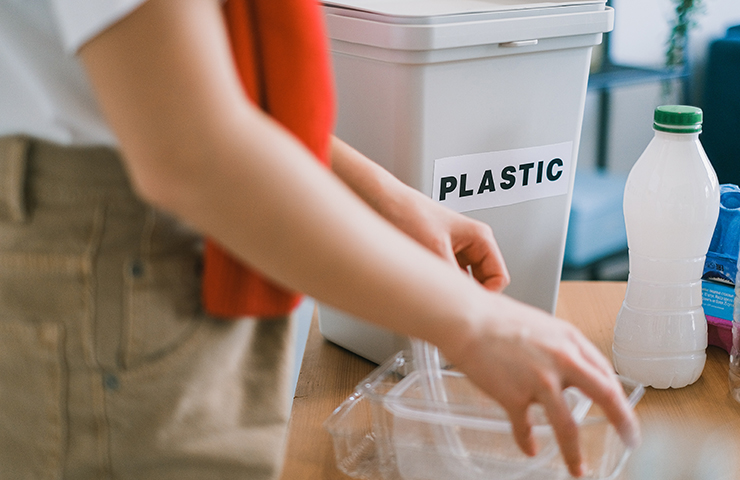Paving the way for a plastic deposit system in Austria

Each year, millions of tons of plastic are produced and turned into a vast range of different products. Yoghurt cups, hairbrushes, pieces of Lego, fishing nets, safety glasses, mobile phones, parts of cars, garden chairs, or bottles - plastic is everywhere. Once it gets into the environment due to improper disposal, the durability of plastic is often a major problem, especially when it gets into the ocean via rivers. Plastic takes decades to break down. However, before it dissolves, it breaks down into smaller and smaller parts due to the influence of the weather, instead of decomposing like wood.
In terms of the Waste Framework Directive, targeted waste avoidance and efficient waste recycling are important. In the future, it will become more and more important to efficiently recover raw materials from waste. Read our blog post about how to turn waste back into resources:
Plastic waste is a global problem
The problem of plastic waste is not just omnipresent, it is also a worldwide issue. Even remote white sand beaches, far from the civilised world, are covered in plastic.
Besides lightweight packaging, it is mainly plastic bottles and aluminium cans that lead to ever higher piles of garbage. Each year, about 1.6 billion plastic bottles and 800 million cans are used in Austria. The bottles make up a substantial part of the roughly 900,000 tons of plastic waste. (see also Global 2000)
To counteract this problem, the European Parliament has adopted a single-use plastics directive. It already entered into force in July 2019 and specifies that a separate collection rate of 90% must be reached by 2029 for the individual material flows from all beverage bottles. As of 2021, all EU member states have to pay a plastic tax on all plastic packaging that is not recycled. This plastic tax is paid for with taxpayers’ money. (see also EC)
Thus, it’s up to the Austrian government to act: to pay less plastic tax to the EU, the amount of plastic waste in Austria must be drastically reduced. After one and a half years of intensive negotiations an agreement seems to have been reached as of the middle of October 2021: Starting in 2025, a deposit will be charged for beverage cans and disposable bottles. In this regard Austria is following the example set by other countries.
This deposit system is part of a 3-point plan that was established and presented by the Austrian Federal Ministry for Climate Action, Environment, Energy, Mobility, Innovation and Technology.
A detailed look at Austria's 3-point plan
Let us take a closer look at the proportion of reusable packaging, the deposit on beverage cans and disposable bottles, and the packaging material fee:
Proportion of reusable packaging:
In the future, all consumers should have a “real” choice: those who want to opt for reusable packaging should be able to purchase reusable packaging. To increase the proportion of reusable packaging in the retail sector, there will be mandatory rates: at least 25% from 2023 onwards, at least 40% from 2025 onwards, and at least 55% from 2030 onwards.
Deposit on beverage cans and disposable bottles:
In order to facilitate recycling and to provide an incentive to return non-reusable beverage packaging to the shop, a deposit is to be charged for plastic bottles and cans in the future. A corresponding model was established withthe main industry representatives, such as beverage producers, manufacturers of collection and recycling systems as well as trading and disposal companies.
Packaging material fee for plastic packaging:
According to the polluter pays principle, whoever causes the costs to be incurred also bear the costs. Therefore, an average fee of 80 cents per kilogram will be charged for all plastic packaging put on the market. According to this principle, the fee will be staggered - it will be lower for packaging that is suitable to be recycled or is made up of a large proportion of recycled material. Conversely, the fee gets higher the more harmful the packing is to the environment. (BMK: Federal ministry for Climate Action, Environment, Energy, Mobility, Innovation and Technology. 2020)
If you want to know more about current topics in waste management and how these processes are mapped in an ERP system, please contact us. Our experts will be happy to advise you on all aspects of waste and our industry solution COSMO Environmental Services:
Conclusio
The implementation of this 3-point plan will lead to several incentive effects: The use of alternative packaging material and packaging with a high proportion of recyclable material is rewarded and will thus lead to a higher recycling rate. In turn, a higher recycling rate reduces the amount of plastic tax to be paid. The manufacturers and importers will then benefit from that thanks to a lower packaging material fee. If the proportion of reusable packaging increases, the amount of plastic waste automatically decreases, and the new deposit system will hopefully mean that fewer bottles and cans are improperly disposed of in the future.
Sources
Global 2000, s.a.: https://www.global2000.at/pfandsystem-oesterreich (retrieved on 29.10.2021)
BMK, 2020: https://infothek.bmk.gv.at/pfandsystem-fuer-oesterreich-3-punkte-plan/ (retrieved on 29.10.2021)
European commission, s.a. https://ec.europa.eu/environment/topics/plastics/single-use-plastics_de (retrieved on 02.11.2021)
